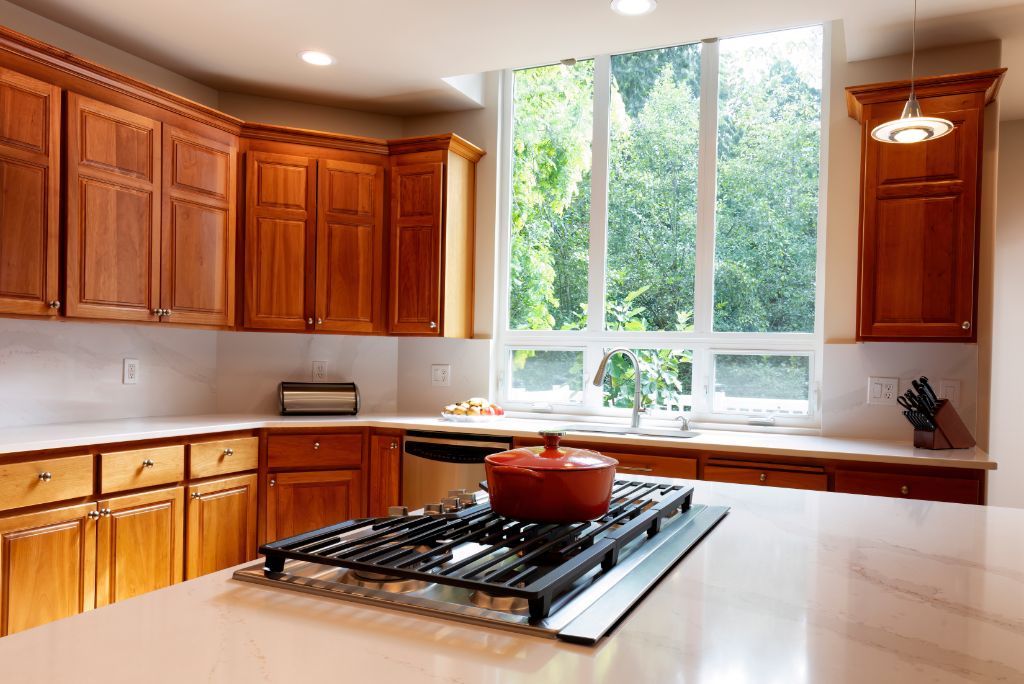
A Step-By-Step Guide To Refinishing Cabinets
Are you tired of looking at your dull and dingy cabinets every day? If so, then it’s time to give them a facelift! In this article, we’ll show you how to refinish your cabinets in just a few simple steps. With the right approach and tools, you can make your cabinets look like new again without breaking the bank. Read on to find out more!
Why Refinishing Cabinets?
If your cabinets are looking tired and outdated, refinishing them is a great way to give them a fresh, new look. It’s also a much cheaper option than replacing them entirely.
There are two main ways to refinish cabinets: painting and staining. Painting is the easier option, but it doesn’t provide the same wood grain look as staining does. If you’re unsure which route to take, we recommend hiring a professional painter or refinisher to help you out.
The process of refinishing cabinets is pretty straightforward, but it does require some time and effort. Here’s a step-by-step guide to help you get started:
1. Prepping the Cabinets
Whether your cabinets are starting to show their age or you’re simply looking for a change, refinishing them is a great way to give them a fresh new look. But before you start, there are a few things you need to do to prep the cabinets.
- Remove all hardware: Take off the knobs, pulls, and hinges from the doors and drawers.
- Clean the surfaces: Use a degreaser or TSP solution to remove any dirt or grease buildup.
- Sand the cabinets: This step helps the new finish adhere better to the surface.
- Prime the cabinets: Choose a primer suitable for wood surfaces to ensure a smooth finish.
2. Painting or Staining Your Cabinets
Whether your cabinets are made of wood, metal, or laminate, you can give them new life with a fresh coat of paint or stain.
- Painting: Use a primer before applying paint for better adhesion and a smoother finish. Choose a color that complements your kitchen decor.
- Staining: Test the stain on a hidden area first to determine the final color. Apply evenly with a brush or rag and wipe away excess for a clean finish.
3. Reassembling and Installing Your Cabinets
After refinishing cabinets, it’s time to put everything back together.
- Attach doors and drawers: Use the same hinges and hardware or choose new ones that match your style.
- Install cabinets: Make sure they are level and flush with the surrounding surfaces.
- Add hardware: Choose knobs and pulls that complement your new cabinet finish.
Step by Step Instructions
- Clean the cabinets with a degreaser and a scrub brush.
- Remove all the hardware from the cabinets.
- Sand down the cabinets with a coarse grit sandpaper.
- Wipe down the cabinets with a damp cloth to remove any dust particles.
- Apply a primer to the cabinets with a paintbrush or roller.
- Wait for the primer to dry before moving on to the next step.
- Paint the cabinets with a color of your choice using a paintbrush or roller.
- Allow the paint to dry completely before adding any new hardware to the cabinets.
How to Mix Colors
Sometimes when you want to add a pop of color to your home, you need to put in some extra effort. You can try contacting a professional interior decorator, but if you want to do it your own way, there are some resources that can help you like the Pantone website. Once you select a few colors for your room or area of the house, mix them together to make your own! When choosing colors for the interior and exterior of your home,
it is important to remember that the general rule of thumb is to use five percent of color on the walls and decorations and use ten percent on furniture. For example, if you want to paint an entire room white, it’s best to use three coats of white paint.
Choosing the Right Stain and Finish
If your cabinets are looking a little worse for wear, refinishing them is a great way to give them a new lease on life. But before you start, it’s important to choose the right stain and finish. Here are a few things to keep in mind:
- The type of wood your cabinets are made of.
- The level of wear and tear.
- Your personal style.
Aftercare Tips for Refinished Cabinets
Once you have finished refinishing your cabinets, it is important to take care of them properly to ensure that they stay looking like new for as long as possible.
- Wipe down the cabinets with a damp cloth on a regular basis.
- If you notice any fingerprints or smudges, clean them off immediately.
- Be careful when using cleaners or chemicals near your cabinets.
- Avoid putting hot pans or other items directly on cabinet surfaces.
Alternatives to Refinishing Cabinets
In addition to refinishing your cabinets, there are a few alternative ways to make them look like new again.
- Paint them.
- Replace the hardware.
- Add new features.
Refinishing cabinets can be a rewarding and cost-effective way to make them look like new again. With the right tools, supplies, and guidance from this step-by-step guide, you are sure to achieve beautiful results that will last for years.
Give AMD Remodeling a call today at 469-547-5887 for expert assistance with your cabinet refinishing project!
Conclusion
Refinishing cabinets is a fantastic way to breathe new life into your kitchen without breaking the bank. By following these steps, you can transform your dull and outdated cabinets into beautiful focal points of your home. Remember to take your time, choose the right materials, and enjoy the process!
FAQs
1. How long does it take to refinish cabinets?
Refinishing cabinets can take anywhere from a few days to a couple of weeks, depending on the size of your kitchen and the extent of the work needed.
2. Can I refinish laminate cabinets?
Yes, you can refinish laminate cabinets, but the process may require additional preparation steps to ensure adhesion.
3. Do I need to sand before painting cabinets?
Sanding is recommended before painting cabinets to ensure better adhesion and a smoother finish.
4. How much does it cost to refinish cabinets?
The cost of refinishing cabinets varies depending on factors such as the size of your kitchen, the materials used, and whether you hire professionals or DIY.
5. Can I change the color of my cabinets?
Yes, you can change the color of your cabinets by either painting or staining them to achieve your desired look.
Refinishing your cabinets is a rewarding DIY project that can enhance the aesthetic appeal and value of your home. Get started today with AMD Remodeling and enjoy your newly transformed kitchen in Allen, TX!
